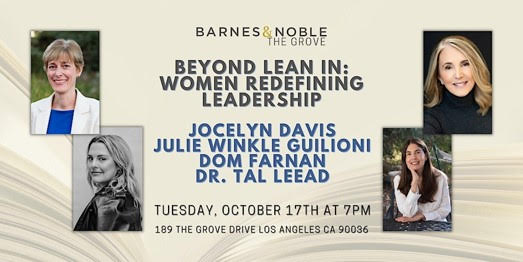
Women in leadership get a lot of advice, most of it unhelpful. The first step in finding our way is to recognize and reject poor direction, so let’s take a look at three main types of advice served up to women by career gurus:
-
- Lean in
- Aim to please
- Walk the tightrope
1. Lean in.
Sheryl Sandberg’s book of this name is the best-known in a large collection of similar guides that urge women to be more assured and direct—to “sit at the table,” as Sandberg puts it, rather than in a side chair. Some of these advisers take a kindly big-sister tone: be confident, don’t sell yourself short, I’m rooting for you. Others are more in the tough-love vein: it’s a man’s world and the men play hardball, so quit your whining and learn to play hardball yourself. Some say this type of counsel is geared to rich women with household help and super-supportive husbands, a criticism that seems justified: if you’re a single mom who has to pick up the kids at daycare then pull a second shift of dinner prep, homework, baths, bedtime, and a couple more hours of email, laundry, and worrying about the bills before finally getting to sleep after midnight, you’re not going to have much energy left for rocking the morning meeting.
But the larger problem with this category of advice isn’t the elitist myopia; it’s the assumption that climbing a corporate ladder is the only game in town and that the rules of that game must always be followed. Of course, the lean-in proponents will counter that if climbing a corporate ladder isn’t your thing, their book isn’t for you. By anchoring their advice in corporate structures, however, they overlook the many paths for women that involve dodging or subverting those structures even while operating within or alongside them. Many successful female leaders of history engaged in just that sort of subversion: they played a man’s game, not by his rules. Or they stepped out of the game to invent a new one. Leaning in is fine, but (to quote Georgetown law professor Rosa Brooks) there is much to be said for leaning out.
2. Aim to please.
These advisers would have us drop all attempts at hardball and instead work to become, in the words of Marabel Morgan’s bestselling book of 1973, a “total woman.” The original total woman was a homemaker who’d go to any lengths to please her husband, whether by flattering him, cooking his favorite meals or (as the author famously suggested) greeting him at the door in the evening wearing nothing but three Dixie Cups. The Total Woman lifted to prominence an entire self-help genre focused on techniques for finding, catching, and keeping a successful male partner. Dating and marriage are the main topics, but there’s also a subgenre that counsels women in the workplace to soften their approach and polish their appearance in order to form alliances with men who’ll look out for them professionally. I remember reading about one women’s workshop—I don’t recall the sponsor—at which attendees were instructed to wear “the three Ps: pink, pumps, and pearls” in order to ensure their advancement at the office. (Again we see the bias toward women who can afford pearls.)
Morgan and her ilk are easy to mock, but their advice isn’t crazy. They believe in gender complementarity: that men and women have different natures entailing different strengths, and that we should play to those strengths. The concept of a “female brain,” though questioned by most neuroscientists, crops up often in the sort of book that may not tell women to wear the three Ps but does tell them to use their supposedly superior teamwork abilities, listening skills, or empathy in order to stand out from the men and get ahead. Again, not crazy. The drawback of this type of advice, though, is that “strong and complementary” can easily devolve into “weak and lesser.” A badass woman can wear pink, pumps, and pearls, but at some point, she’s likely to find those heels slowing her down. (Not to mention the Dixie Cups.)
3. Walk the tightrope.
The so-called tightrope dilemma is the need to walk the line between competence and likability. It’s a balance easy for men to strike, and hard for women. Research shows that a man perceived as competent tends also to be perceived as likable, while the more competent a woman seems the less likable she seems, and the more likable, the less competent. A competent woman pursuing a higher position is especially apt to be disliked; once she achieves the higher position (if she achieves it) and starts actually doing the job, her competence and likability are easier for people to reconcile. Gurus therefore suggest we walk the tightrope by, basically, disguising our ambition: smile a lot, act friendly, tout our team’s accomplishments rather than our own, say “we” not “I,” and never, ever let on that we aspire to the boss’s job. In other words, go ahead and be competent—just don’t act like we expect to be rewarded for it.
This genre of advice acknowledges the shortcomings of “lean in” and “aim to please” and tries to combine the two approaches into one, whereby we project a perfect balance of strength and warmth while cleverly hiding our will to power. It’s a sophisticated take on what works for women; the problem is that balancing acts are exhausting. Who can walk a tightrope all day, every day? Thinking back on my own attempts to do it over a 25-year consulting career, I can see that although I often succeeded, it was only because I was lucky enough to work in a place unusually supportive of women. Our company’s senior staff was mostly female; moreover, the company founder (a man) had made it his explicit aim to create a woman-friendly culture. That culture lasted as long as a home-grown CEO was in charge, but when a new regime took over, I was shocked to see how quickly the tightrope got yanked out from under us women leaders, our balancing acts were no longer effective or appreciated.
To my mind, we need some whole new categories of advice:
-
-
- Instead of lean in—range wide.
- Instead of aim to please—aim to grow.
- Instead of walk the tightrope—stand firm, flow through, fly high, or shine bright.
-
As I say in Insubordinate (with apologies to philosopher Jean-Jacques Rousseau), “Woman is born free, and there are a thousand ways to break the chains.”
Adapted from Insubordinate: 12 New Archetypes for Women Who Lead, by Jocelyn Davis (Amplify Publishing, 2023)
 Register now for the Beyond Lean In tour!
Register now for the Beyond Lean In tour!
The Beyond Lean In: Women Redefining Leadership author panel, book signing, and networking event is happening in LA at 7 pm on Tue Oct 17, at Barnes & Noble The Grove.
This event will be a fun, chill evening of good discussion, good books, and good company, with women’s voices amplified, high-quality connections to be made, and fresh perspectives to be discovered on the themes of leadership and career success.
Click here to learn more and register for the Los Angeles event. But if LA is not your home, you can enjoy this remarkable event in New York, Boston, Washington DC, or Austin.
 Jocelyn Davis is an internationally known author and speaker, formerly EVP, Research & Development, for The Forum Corporation, a global leadership and sales development consultancy serving Fortune 1000 clients. Her previous business books include Strategic Speed, The Greats on Leadership, and The Art of Quiet Influence. She’s also the author of a historical novel, The Age of Kali, called “brilliant,” “heretical,” and “deeply moving.” Jocelyn holds master’s degrees in philosophy and Eastern classics and loves bringing timeless wisdom from many cultures to bear on modern-day leadership challenges. She grew up in a foreign-service family living in many regions of the world, including Southeast Asia, East Africa, and the Caribbean. Currently, she lives in Santa Fe, New Mexico.Photo by from Pixabay
Jocelyn Davis is an internationally known author and speaker, formerly EVP, Research & Development, for The Forum Corporation, a global leadership and sales development consultancy serving Fortune 1000 clients. Her previous business books include Strategic Speed, The Greats on Leadership, and The Art of Quiet Influence. She’s also the author of a historical novel, The Age of Kali, called “brilliant,” “heretical,” and “deeply moving.” Jocelyn holds master’s degrees in philosophy and Eastern classics and loves bringing timeless wisdom from many cultures to bear on modern-day leadership challenges. She grew up in a foreign-service family living in many regions of the world, including Southeast Asia, East Africa, and the Caribbean. Currently, she lives in Santa Fe, New Mexico.Photo by from Pixabay

